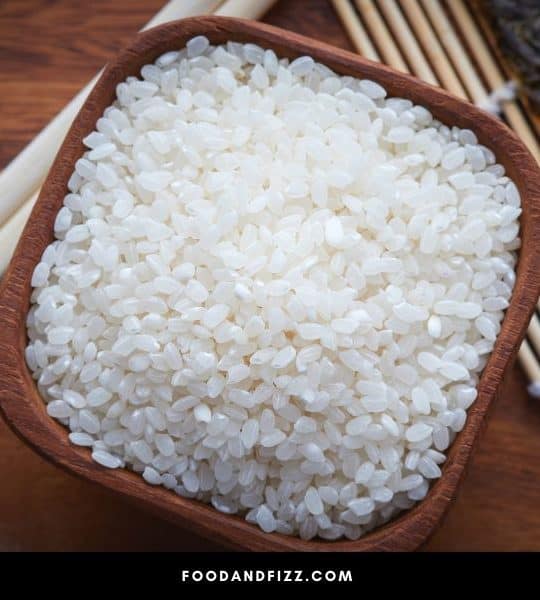At first glance, sushi rice and white rice may look like the same thing. They are both rice, they are both white, and both are used as accompaniments to savory dishes.
But are they really that similar? Read on to find out.
Sushi Rice vs White Rice
Sushi rice is rice that is seasoned with salt, sugar, and vinegar and is made from a Japanese short-grain rice variety called uruchimai. White rice is processed rice that has the bran and germ removed. The rice variety used to make sushi rice belongs to a certain category of white rice.

Takeaways Sushi Rice vs White Rice
| WHITE RICE | SUSHI RICE | |
| ORIGIN | Any type of white rice | "Uruchimai" or Calrose Rice |
| TYPE OF GRAIN | Short-grain, Medium-grain or Long-grain | Short Grain |
| SEASONING | Typically unseasoned | Seasoned with salt, sugar, rice vinegar |
| TEXTURE | Range from ultra-sticky to light and fluffy | Sticky and holds its shape |
| USES | Versatile and can be used in many dishes | Can only be used for sushi |
4 Difference Between Sushi Rice and White Rice
It is important to know how different sushi rice and white rice are from each other. While they are related, they are not always interchangeable. To protect the integrity of your dishes, it is important that we be able to tell the difference between the two.
So how are sushi rice and white rice different from each other?
1. Origin and Classification
White rice can generally be classified into three categories depending on the size of the grains. There is short grain rice, medium grain rice, and short grain rice.
The term “white rice” may pertain to any of the rice varieties all over the world that fall into these categories.
Sushi rice, on the other hand, is made from a specific Japanese short-grain rice variety called uruchimai. In the U.S., sushi rice is sometimes also made from Calrose rice, a medium grain white rice cultivated in California.
In short, sushi rice can be considered a kind of white rice but not all white rice can be suitably called sushi rice.
2. Seasoning
Sushi rice, for it to be called as such, is seasoned rice. It is seasoned with a mixture of salt, sugar, and rice vinegar and sometimes infused with a seaweed called kombu.
This seasoning achieves that balance of sweet, salty and sour that sushi rice is known for, which complements the seafood toppings usually used.
White rice is not necessarily seasoned and flavored. Of course, it is versatile and can be used in many different ways but white rice in its most basic form is just plain and unseasoned.
3. Texture
Sushi rice is ideally made from rice that is sticky, moist, and holds up its own when shaped into logs or balls for sushi. It is typically made with the Japanese short grain rice variety uruchimai, or Calrose rice, which lends a similar kind of stickiness.
White rice has a variety of textures depending on the type of grain. It can range from ultra-sticky rice for puddings and desserts, to the light and fluffy rice used for salads and pilafs.
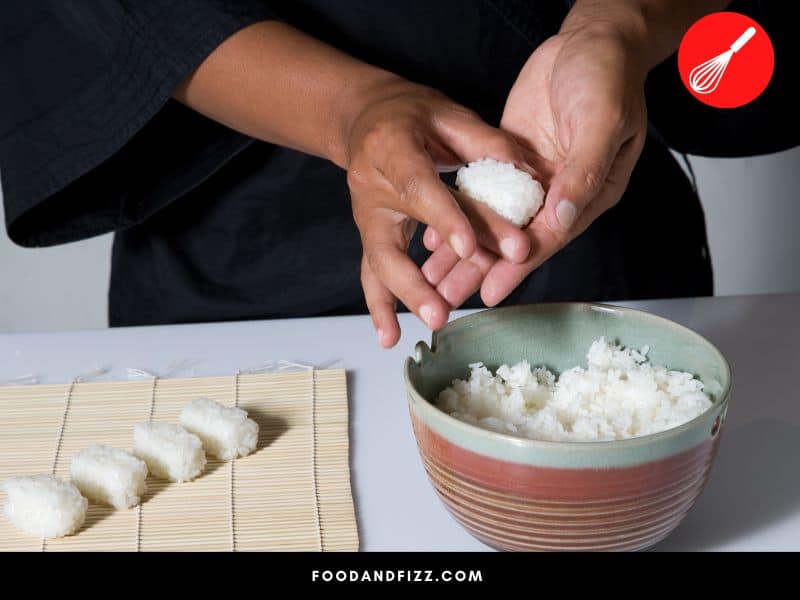
4. Uses
Sushi rice is typically only used for sushi as it is seasoned specifically for that. White rice, on the other hand, can be used for a variety of different things like sweet desserts, fried rice, curries, soups, salads, and pilafs.
Sushi rice and white rice do have similarities, as sushi rice is also white rice. But knowing the specific differences between them ensures that your recipes are always successful and delicious.
White rice is a broad category of rice that includes many different types, and each recipe would have an ideal type of white rice to use.
What Is Sushi Rice?
Sushi rice is rice that has been prepared and seasoned with salt, sugar, rice vinegar, and sometimes infused with kombu to achieve a rice that is sweet, salty, and sour at the same time.
It is designed to complement and enhance the flavor of its toppings, typically raw seafood, and make it more appealing and delicious.
Origins of Sushi Rice
The concept of sushi rice is thought to have originated in China, around the 5th and 3rd centuries BC. To make the fish last longer, it was salted and wrapped in rice.
The bacteria produced from this fermentation in rice and salt made the fish last longer. The rice was initially discarded and not consumed, but later on, people started consuming the rice as well. It later evolved into a dish called narezushi, which is believed to be the earliest ancestor of sushi.
Sushi slowly evolved and progressed in Japan, passing many forms, and by the 17th century, a man by the name of Matsumoto Yoshiichi from Edo (modern-day Tokyo) discovered that if vinegar was added to the rice mix, the fermentation process became significantly shorter and the dish can be consumed much earlier than if the traditional fermentation process was done. It can be ready in days instead of months.
By 1820, a man named Hanaya Yohei was the first to commercialize sushi and was the first to make it into the form that we recognize today – thin strips of seafood delicately placed on top of vinegared rice.
What began as something that was necessary for food preservation, evolved into something that is appreciated for its taste, and is used to enhance flavor and texture.
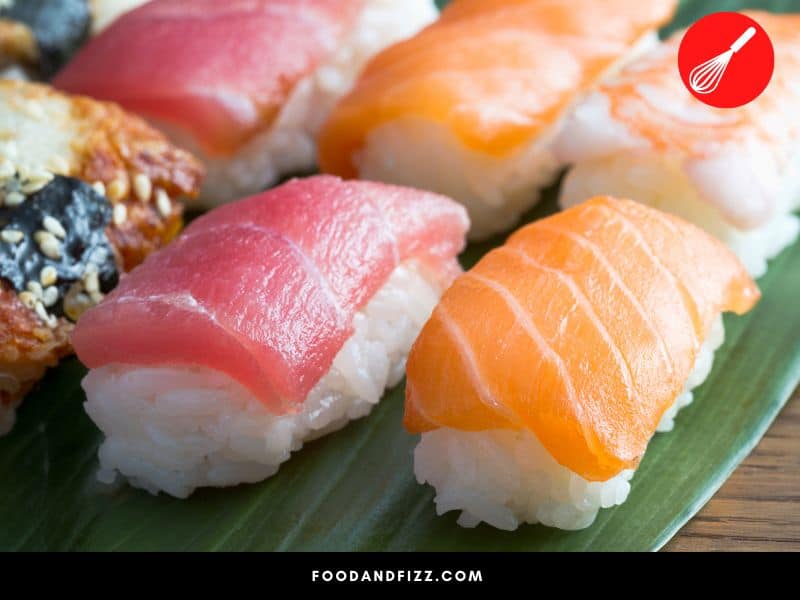
Is Sushi Rice Healthy?
Sushi rice is typically made from a variety of short-grain white rice, which contains quite a high amount of starch and carbohydrates.
White rice is typically more processed than its brown rice counterpart and may contain virtually no fiber and protein. Excess consumption of refined carbohydrates may contribute to health issues if not kept in check.
Sushi does have health benefits and can be part of a healthy diet especially if prepared correctly. However, it is important that it be consumed it in moderation, as with other kinds of food.
What Is White Rice?
The processing of white rice entails the removal of the bran and the germ. Because of this, white rice is easily digestible, however, as most of the nutrients are found in the bran and the germ, it loses most of its nutritional benefits.
White rice though is a good source of energy and when consumed in moderation, can be part of a healthy diet. It is considered a staple food in many countries in the world, which is why its uses are also as diverse.
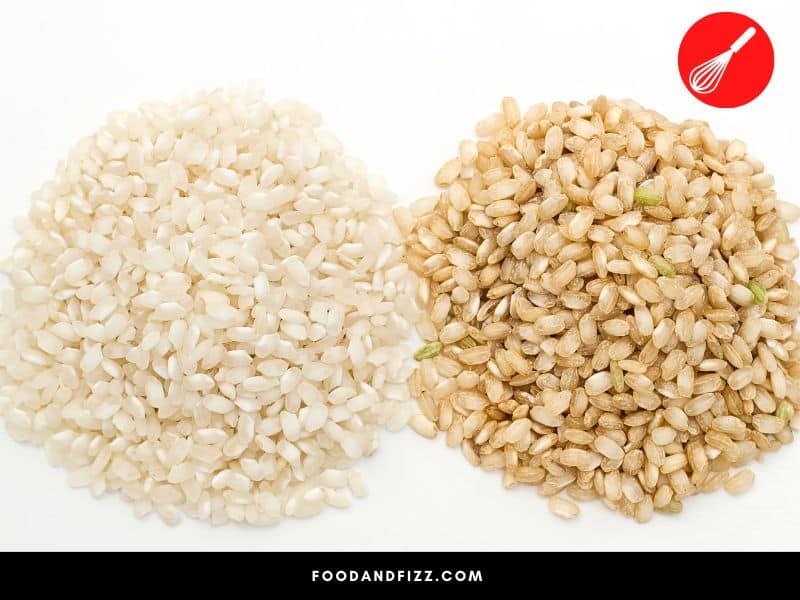
There are many different types of rice varieties in the world, but they are generally grouped into three categories:
1. Short Grain Rice
Short grain rice tends to be starchier, and thus stickier, and is perfect for applications where you need the rice to be moist and sticky, such as in sushi.
The rice typically used to make sushi rice is a Japanese short grain variety called uruchimai. Arborio rice for risottos and Spanish bomba rice for paellas are examples of short grain rice. Some types of sticky rice or glutinous rice are also part of this category.
2. Medium Grain Rice
Less starchy than short grain rice, medium grain rice varieties typically have bigger grains than short grain rice, but not as big as long-grain varieties.
An example of medium grain rice is Calrose rice, which is also one of the most effective substitutes for Japanese rice in making sushi rice.
Japonica rice in Asian countries that are the regular everyday rice is typically part of this category. Medium grain rice becomes sticky and becomes quite clumpy as it cools down.
Other examples include carnaroli rice from Italy, although sometimes arborio and bomba rice are also considered medium grain rice. Sometimes short grain and medium grain rice are lumped into one category, too.
3. Long-Grain Rice
Long grain varieties are grains whose lengths are three to five times longer than their width. They cook up dry, fluffy, and separate, and are best used for salads and pilafs. Examples are Basmati rice and Jasmine rice.
While they are all white rice, they have different properties and characteristics that are worth taking note of. They cannot usually be substituted for each other since they behave differently in recipes. The best bet to ensure success in recipes is to substitute within the same class of grains.
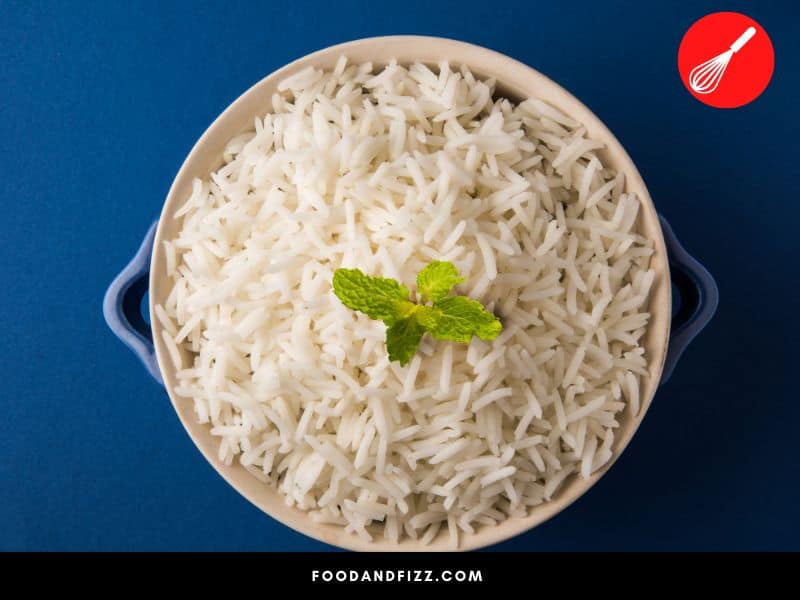
Is White Rice Healthy?
Removing the bran and the germ from white rice makes it lighter and more easily digestible. The bran and germ, though, contain most of the nutritious health benefits of rice so it can be said that white rice, if not enriched, would be lacking in nutritional benefits compared to its less refined counterpart, brown rice.
However, when consumed as part of a balanced diet, it can be a good source of energy and accompaniment to healthier foods.
Can I Use Any Type Of White Rice For Sushi Rice?
Sushi rice requires a specific type of texture and consistency which can only be achieved by using the right variety of rice.
Using other short grain white rice varieties may possibly bring success but long grain varieties would not clump enough to achieve that characteristic sushi rice texture. The best-known substitute for Japanese short-grain rice is Calrose rice.
Can I Substitute Sushi Rice for White Rice?
Sushi rice is rice that is flavored with rice vinegar, salt and sugar, and sometimes kombu. Its flavor is intended to be used for sushi, and may not work if used with dishes with different flavor profiles. Sushi rice may be substituted for white rice but it may not work in the dish.
However, if we mean to ask if we can cook and use the rice used to make sushi rice and use it as we would everyday white rice, then the answer is yes, we can. In Japan, the rice variety used to make sushi rice is used as table rice or everyday rice and is used in a variety of dishes.
Conclusion to Sushi Rice vs White Rice
Sushi rice is rice that is flavored with rice vinegar, salt, and sugar. Sometimes it is also infused with kombu, a type of seaweed.
The rice variety used to make sushi rice is Japanese short-grain rice called uruchimai. White rice is a broader category of rice that includes this rice variety as well as other types of short grain rice as well as medium and long grain rice.
Knowing the difference ensures that you always use the right type of rice to maintain the integrity of your dishes.
Frequently Asked Questions to Sushi Rice vs White Rice
Can I Use White Rice for Sushi?
Sushi rice requires that rice be sticky and moist so that it can be shaped and formed into balls or logs and can easily be picked up by chopsticks or picked up by hand. Short grain white rice varieties that are starchy may work as substitutes but long grain varieties like Basmati and Jasmine will most likely not work.
Is Sushi Rice the Same as Sticky Rice?
Sushi rice may be moist and sticky but it is very different from what is called sticky rice. Sticky rice belongs to the short grain category of rice that is also known as sweet rice or glutinous rice, and is used for desserts all across Asia. It is a different variety than the one used to make sushi rice.
Is Sushi Rice Healthy?
Sushi rice is flavored with sugar, salt and rice vinegar and is made from a kind of short grain white rice. White rice is starchy and high in carbohydrates so when consumed in unhealthy amounts, it may lead to health issues. It can be part of a healthy diet though when consumed in moderation.

